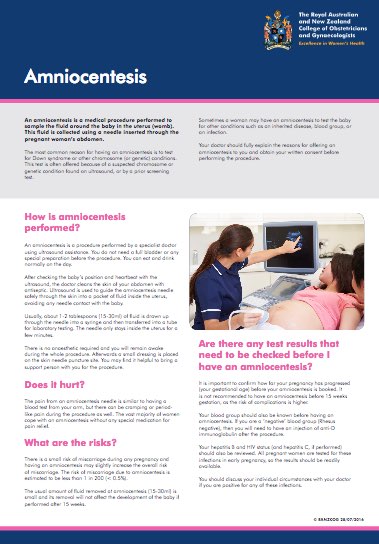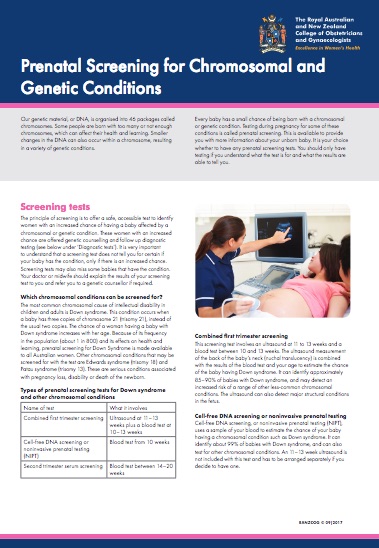Wishing everyone happy holidays and a joyful New Year from the Healthify team. Don't forget to Slip, Slop, Slap and Wrap!
Non-invasive prenatal testing (NIPT)
Key points about non-invasive prenatal testing (NIPT)
- Non-invasive prenatal testing is one of the screening tests you may be offered during pregnancy.
- It's up to you whether to have this test or not.
- NIPT is used to check the risk of your baby being affected by 3 major genetic differences – Down syndrome, Edwards' Syndrome and Patau Syndrome.
- Most people are tested when they are 10 to 12 weeks pregnant.
- It's not funded in Aotearoa New Zealand so you will have to pay for the blood test and lab processing.

The test is used to check the risk of your baby/embryo being affected by 3 major genetic differences:
- Trisomy 21 (an extra copy of chromosome 21, commonly called Down Syndrome)
- Trisomy 18 (an extra copy of chromosome 18, commonly called Edwards’ Syndrome)
- Trisomy 13 (an extra copy of chromosome 13, commonly called Patau Syndrome)
NIPT works by testing the mother’s blood for genetic material from the placenta, which naturally passes into the mother’s bloodstream from 10 weeks of pregnancy onwards.
You have chromosomes in every cell in your body. Chromosomes contain the genetic material (DNA) passed down from your parents, and instruct the cells how to work. Usually there are 46 chromosomes, arranged in 23 pairs.
A trisomy describes the presence of an extra chromosome in each cell. This may occur by chance whenever an egg or sperm are made. A person affected by a trisomy can have a wide range of significant health issues, including intellectual disability, defects in how the internal organs develop and a moderate to severe decrease in life expectancy.
The test can be done at any time in pregnancy after 10 weeks. Most people choose to do it between 10–12 weeks. You will need to be referred for NIPT. The referral can come from any registered health professional, eg, your Lead Maternity Carer (LMC).
Currently in Aotearoa NZ there is no public funding for NIPT, so you have to pay the full cost of the blood test and lab processing.
It is recommended that an ultrasound scan is also performed (before 14 weeks of pregnancy) to allow the results to be correctly interpreted. For example, the results are interpreted differently if there are twins. You may be charged a fee for the scan.
A blood sample is sent to a specialist laboratory. Awanui(external link) is the only provider that currently undertakes the testing in Aotearoa New Zealand. Other laboratories send samples overseas for testing, meaning that it takes longer to get a result back.
The result will either be low risk, high risk or a test failure.
- Low-risk – routine pregnancy care is advised. This would include a detailed ultrasound scan at 18–20 weeks to check for any problems with the development of the baby, usually unrelated to genetic issues.
- High-risk for one of the genetic differences above. Your LMC should refer you to an expert to discuss the result before you make any decisions about the pregnancy.
- Test failure – no result available. This is most likely to happen if the test is done too early in your pregnancy.
It is important to remember that NIPT is a screening test only, not a diagnostic test. Additional testing is needed to tell whether your baby is definitely affected by a genetic difference.
If you have a ‘high-risk’ result, you may be offered an optional diagnostic test after counselling, to check whether the baby is affected or not. This would be performed by an invasive test (chorionic villous sampling/CVS or amniocentesis). Both of these tests carry a risk of miscarriage.
It should be noted that some labs will report on other possible genetic differences in addition to the 3 major trisomies, which can cause a lot of anxiety and uncertainty. NIPT is not nearly as reliable when looking at other genetic issues.
NIPT is a newer alternative test to MSS1 or MSS2, which are also available to anyone pregnant in Aotearoa NZ. They are all screening tests, which mean they are relatively easy, cheap, safe and convenient compared to diagnostic tests.
Compared to the older screening tests, NIPT is more expensive, but is much more likely to detect a baby with one of these 3 major genetic conditions. It is also much less likely to give a ‘high-risk’ result when the baby is not affected by these genetic differences (called a false positive result).
NIPT is relatively new in Aotearoa NZ, but is well established and becoming routine overseas. It is important that any ‘high-risk’ result is discussed properly with an NIPT expert as it is still unfamiliar to many healthcare providers.
Illumiscreen non-invasive prenatal screening(external link)
Apps
Resources
Amniocentesis(external link) RANZCOG, NZ, 2021
Chorionic villus sampling(external link) RANZCOG, 2021
Prenatal screening for chromosomal and genetic conditions(external link) RANZCOG, Australia, 2017
Brochures

RANZCOG, NZ, 2021

Credits: Dr Janet Crofts, Obstetrician, Auckland
Reviewed by: Healthify editorial team. Healthify is brought to you by Health Navigator Charitable Trust.
Last reviewed:
Page last updated:





